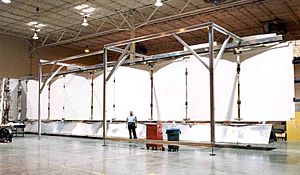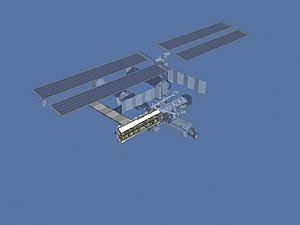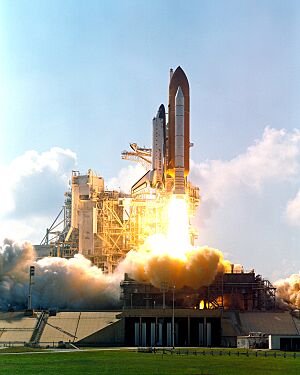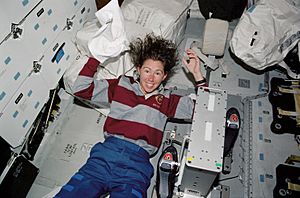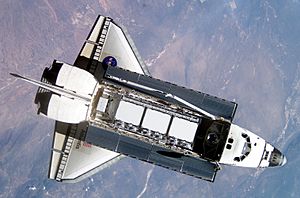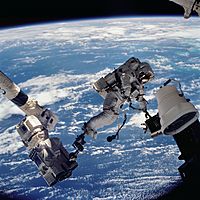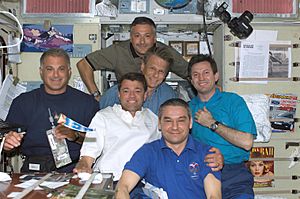STS-112 facts for kids
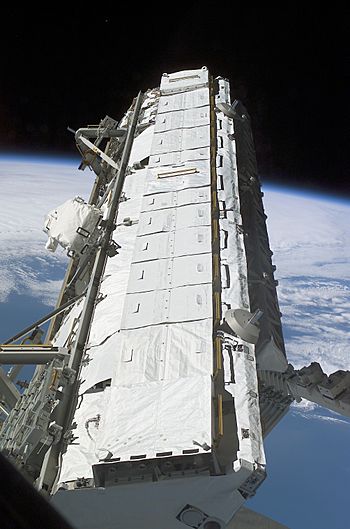
Canadarm2 takes the S1 truss out of the payload bay of Atlantis, prior to its installation on the ISS
|
|
| Mission type | ISS assembly |
|---|---|
| Operator | NASA |
| Mission duration | 10 days, 19 hours, 58 minutes, 44 seconds |
| Distance travelled | 7,200,000 kilometres (4,500,000 mi) |
| Orbits completed | 170 |
| Spacecraft properties | |
| Spacecraft | Space Shuttle Atlantis |
| Launch mass | 116,538 kilograms (256,922 lb) |
| Landing mass | 91,390 kilograms (201,480 lb) |
| Payload mass | 12,572 kilograms (27,717 lb) |
| Crew | |
| Crew size | 6 |
| Members |
|
| Start of mission | |
| Launch date | 7 October 2002, 19:45:51 UTC |
| Launch site | Kennedy LC-39B |
| End of mission | |
| Landing date | 18 October 2002, 15:44:35 UTC |
| Landing site | Kennedy SLF Runway 33 |
| Orbital parameters | |
| Reference system | Geocentric |
| Regime | Low Earth |
| Perigee | 273 kilometres (170 mi) |
| Apogee | 405 kilometres (252 mi) |
| Inclination | 51.6 degrees |
| Period | 91.2 minutes |
| Docking with ISS | |
| Docking port | PMA-2 (Destiny forward) |
| Docking date | 9 October 2002, 15:16 UTC |
| Undocking date | 16 October 2002, 13:13 UTC |
| Time docked | 6 days, 21 hours, 57 minutes |
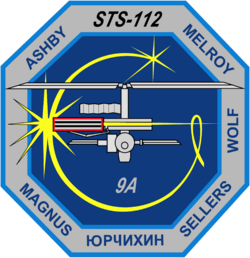 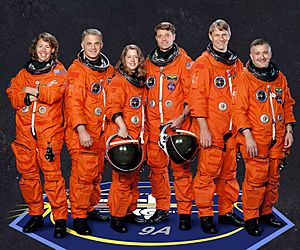 (L-R): Sandra H. Magnus, David A. Wolf, Pamela A. Melroy, Jeffrey S. Ashby, Piers J. Sellers and Fyodor Yurchikhin |
|
STS-112 was an exciting 11-day Space Shuttle mission to the International Space Station (ISS). The mission was flown by the Space Shuttle Atlantis. It was a very important flight for building the ISS, known as assembly flight 9A.
Atlantis launched on October 7, 2002, from the Kennedy Space Center in Florida. Its main job was to deliver a huge, 28,000-pound part called the Starboard 1 (S1) truss segment to the Space Station. After traveling 4.5 million miles, Atlantis landed safely back at the Kennedy Space Center on October 18, 2002.
During the launch, a piece of foam broke off the shuttle's external tank. It hit the left Space Shuttle Solid Rocket Booster, causing a dent. NASA looked into this issue. They decided it was safe to continue with planned launches. The next shuttle launch after this one was the Space Shuttle Columbia disaster (STS-107).
Atlantis was supposed to fly again in March 2003. However, because of the Columbia accident, all Space Shuttles were temporarily stopped from flying. Atlantis didn't fly again until September 9, 2006, on mission STS-115.
Contents
Meet the Crew
The STS-112 mission had a crew of six brave astronauts. Here's who they were:
| Position | Astronaut | |
|---|---|---|
| Commander | Third and last spaceflight |
|
| Pilot | Second spaceflight |
|
| Mission Specialist 1 | First spaceflight |
|
| Mission Specialist 2 | First spaceflight |
|
| Mission Specialist 3 | Third spaceflight |
|
| Mission Specialist 4 | First spaceflight |
|
What the Mission Carried
The Space Shuttle Atlantis carried several important items into space for the International Space Station.
| Location | Cargo | Mass |
|---|---|---|
| Bays 1–2 | Orbiter Docking System 2 EMU spacesuits |
1,800 kilograms (4,000 lb) 240 kilograms (530 lb) |
| Bays 3–13 | S1 Integrated Truss Segment CETA Cart A |
12,572 kilograms (27,717 lb) 283 kilograms (624 lb) |
| Sill | Remote Manipulator System | 410 kilograms (900 lb) |
| Total: | 15,305 kilograms (33,742 lb) |
The S1 Truss Segment
The most important cargo for STS-112 was the S1 truss segment. A truss is like a strong, supportive framework. This S1 segment helps hold up the Space Station's radiators, which are important for cooling the station.
Companies like Boeing and Lockheed Martin started building this truss in 1998. It was finished in 1999 and then sent to NASA for final checks before its space journey.
Crew Equipment Translation Aid (CETA) Cart
Atlantis also delivered a special cart called the Crew Equipment Translation Aid (CETA) Cart. This cart attaches to the Mobile Transporter on the ISS. Astronauts use it to move equipment around the outside of the Space Station during spacewalks.
Science Experiments on Board
STS-112 carried several science experiments to the Space Station. These included:
- Plant Generic Bioprocessing Apparatus (PGBA)
- Commercial Generic Bioprocessing Apparatus (CGBA)
- Protein Crystal Growth Single-locker Thermal Enclosure System (PCG-STES-PCAM)
- Samples for the Zeolite Crystal Growth Furnace (ZCG) experiment
These experiments helped scientists learn more about how plants grow, how proteins form, and how crystals grow in the microgravity of space.
Shuttle Preparations
Getting Atlantis ready for launch was delayed a little bit. In June 2002, tiny cracks were found in the metal liners of the shuttle's fuel lines. These liners are inside the pipes that carry liquid hydrogen fuel to the engines. Even though the main fuel pipes were fine, engineers worried that small pieces of metal from the liners could break off. If this happened, it could cause a serious engine problem during launch. After careful review, NASA decided it was safe to fly.
Mission Timeline: A Day-by-Day Look
October 7 (Flight Day 1 – Launch)
Space Shuttle Atlantis blasted off from Launch Pad 39B at the Kennedy Space Center. The launch happened smoothly, just as planned. For the very first time in Space Shuttle history, a "rocketcam" video camera was attached to the external tank. This camera sent live video of the launch back to NASA! The video was almost perfect until the two solid rocket boosters separated. At that point, their exhaust made the camera lens foggy.
NASA also looked into a small issue with some explosive bolts. These bolts help the solid rocket boosters separate. During this launch, only one set of explosives fired in ten bolts, instead of all of them. All 10 nuts still exploded as planned, but NASA wanted to understand why this happened.
A more significant event during launch was when a piece of foam, about 4x5x12 inches, broke off the external tank. It hit the lower left solid rocket booster, making a dent about 4 inches wide and 3 inches deep. NASA decided this was not a major risk for future flights. This decision became very important later, especially after the STS-107 tragedy.
October 8 (Flight Day 2 – Getting Ready for Docking)
On their second day in space, the STS-112 crew got ready to meet up and dock with the International Space Station. The astronauts checked their spacewalk suits and equipment. Commander Jeff Ashby and Mission Specialist Sandy Magnus checked the shuttle's robotic arm to make sure it was ready. The crew also prepared the docking system and other tools needed for linking up with the ISS.
During the day, Atlantis fired its engines three times. These "Orbital Maneuvering System" (OMS) burns helped the shuttle get into the correct orbit to approach the Space Station.
Astronaut David Wolf also checked on an experiment called SHIMMER. This experiment uses a special camera to look at Earth's atmosphere, searching for signs of ozone loss. The crew worked with Mission Control to get the experiment ready for observations.
October 9 (Flight Day 3 – Docking with the ISS)
Space Shuttle Atlantis successfully docked with the International Space Station at 15:17 GMT. This began a week of teamwork between the shuttle crew and the Expedition 5 crew already living on the ISS. Commander Jeffrey Ashby carefully guided Atlantis to connect with the Pressurized Mating Adapter-2 (PMA-2) at the front of the station. The two spacecraft were flying 245 miles above Earth.
After checking that everything was sealed tightly, the hatches between Atlantis and the ISS were opened. The astronauts from Atlantis floated into the Destiny Module and were greeted by the three-person station crew. This was the first time the Expedition 5 crew had visitors!
After a safety briefing, the combined crews started preparing for a busy day. Some astronauts got the spacewalk suits ready, while others reviewed how to use the robotic arm to move the new truss segment.
October 10 (Flight Day 4 – First Spacewalk)
The day started early for the Atlantis crew. Astronauts Peggy Whitson and Sandy Magnus used the station's robotic arm, Canadarm2, to grab the S1 truss structure. They carefully moved it out of Atlantis' cargo bay and attached it to the Space Station. Four motorized bolts locked the two parts together.
At the same time, Astronauts Dave Wolf and Piers Sellers got ready for the mission's first spacewalk, also known as an EVA (Extravehicular Activity). This was the 44th spacewalk to help build and maintain the Space Station. Wolf and Sellers left the Quest Airlock at 11:21 AM EDT. Wolf wore a spacesuit with red stripes, while Sellers wore an all-white suit. Wolf worked to connect power, data, and fluid lines between the S0 and S1 trusses. Sellers, on his first spacewalk, released the locks on three folded-up radiators on the S1. This allowed the radiators to be moved into position to cool the station.
The spacewalk lasted seven hours and one minute, which was longer than planned. There was a small problem with the Canadarm2, which meant Wolf had to finish installing a camera system without the robot arm's help. Near the end of the spacewalk, Wolf reported that his helmet earphones were losing power.
Throughout the spacewalk, astronaut Pamela Melroy helped guide the spacewalkers. Shuttle Commander Jeff Ashby operated the shuttle's robotic arm, providing camera views. After finishing their tasks, Wolf and Sellers returned to the Quest Airlock.
October 11 (Flight Day 5 – Rest and Transfers)
On Flight Day 5, the shuttle and station crews had some time off. Then, they started moving items between Atlantis and the ISS. They transferred completed science experiments back to the shuttle to return to Earth. They also moved new experiments to the ISS. For example, liver cell tissue samples were moved to the shuttle for study on Earth.
They also moved special containers for growing protein crystals in microgravity. Seven containers of water were transferred to the station. Commander Jeff Ashby also started transferring about 15 pounds of nitrogen gas from Atlantis to the station.
Spacewalkers David Wolf and Piers Sellers, with help from Pilot Pamela Melroy, got their spacewalk equipment ready for the next EVA. They refilled water in their spacesuits and prepared their tools.
The crew also spoke with news reporters. Astronauts Magnus, Wolf, and Sellers talked about their first spacewalk and what it was like in space. Wolf mentioned that the manual work they did at the end of EVA 1 made their heart rates go up very high! Russian cosmonauts also gave interviews to the Russian press. Before going to sleep, the crew reviewed the plans for their second spacewalk.
Spacewalks
Astronauts David Wolf and Piers Sellers performed all three spacewalks during the STS-112 mission. These spacewalks were crucial for installing and setting up the new parts of the Space Station.
| EVA | Spacewalkers | Start (UTC) | End | Duration |
|---|---|---|---|---|
| EVA 1 | David A. Wolf Piers J. Sellers |
10 October 2002 15:21 UTC |
10 October 2002 22:22 UTC |
7 hours, 01 minutes |
| Connected power, data, and fluid lines between the S0 and S1 truss segments. | ||||
| EVA 2 | David A. Wolf Piers J. Sellers |
12 October 2002 14:31 UTC |
12 October 2002 20:35 UTC |
6 hours, 4 minutes |
| Installed hardware for future spacewalks. | ||||
| EVA 3 | David A. Wolf Piers J. Sellers |
14 October 2002 14:08 UTC |
14 October 2002 20:44 UTC |
6 hours, 36 minutes |
| Finished installing the S1 truss segment. | ||||
Shuttlecam: A New View
A camera called the "Shuttlecam" was mounted on the shuttle's external tank. It recorded Atlantis' journey into orbit. This was the first time such footage was ever captured! However, after the solid rocket boosters separated, the camera lens got foggy from the exhaust.
After the Space Shuttle Columbia disaster (STS-107), this type of camera was used on all future missions. It helped capture images of any debris falling from the external tank during launch.
Wake-Up Calls from Home
NASA has a fun tradition of playing music to wake up astronauts in space. This started during the Gemini program and was first used on Apollo 15. Each song is chosen specially, often by the astronauts' families. The songs usually have a special meaning to an astronaut or relate to what they will be doing that day.
| Flight Day | Song | Artist | Played for | Links |
|---|---|---|---|---|
| Day 2 | "Venus and Mars" | Paul McCartney and Wings | David Wolf | wav |
| Day 3 | "The Best" | Tina Turner | Jeffrey Ashby | wav |
| Day 4 | "(Theme from) The Monkees", "Rocket Man", "Space Oddity", "I am Woman" | The Monkees, Elton John, David Bowie, Helen Reddy | Sandra Magnus | wav |
| Day 5 | "Oh Thou Tupelo" | Wellesley College Choir | Pamela Melroy | wav |
| Day 6 | "Push It" | Garbage | Piers Sellers | wav |
| Day 7 | "The Aviation March" | Hymn of the Moscow Aviation Institute | Fyodor Yurchikhin | wav |
| Day 8 | "You Gave Me the Answer" | Paul McCartney and Wings | David Wolf | wav |
| Day 9 | "Only an Ocean Away" | Sarah Brightman | Sandra Magnus | wav |
| Day 10 | "Prime Time" | The Alan Parsons Project | Pamela Melroy | wav |
| Day 11 | "These Are Days" | 10,000 Maniacs | Piers Sellers | wav |
| Day 12 | "Someday Soon" | Suzy Bogguss | Jeffrey Ashby | wav |
Images for kids
-
JoAnn H. Morgan with STS-112 Pilot Pamela Melroy (left) and Mission Specialist Sandra Magnus (center) after the landing of Space Shuttle Atlantis.
See also
 In Spanish: STS-112 para niños
In Spanish: STS-112 para niños


